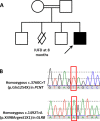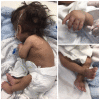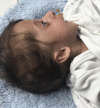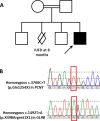Majewski dwarfism type II: an atypical neuroradiological presentation with a novel variant in the PCNT gene
- PMID: 31151966
- PMCID: PMC6557317
- DOI: 10.1136/bcr-2018-224197
Majewski dwarfism type II: an atypical neuroradiological presentation with a novel variant in the PCNT gene
Abstract
Microcephalic osteodysplastic primordial dwarfism syndrome II (MOPDII) is microcephalic primordial dwarfism and is a very rare form of disproportionate short stature. This disorder shares common features with other forms of microcephalic primordial dwarfism, including severe prenatal and postnatal growth retardation with marked microcephaly. However, it includes characteristic skeletal dysplasia, abnormal dentition and increased risk for cerebrovascular diseases. Recent reports added more features, including café-au-lait lesions, cutis marmorata, astigmatism, Moyamoya disease, insulin resistance, obesity, abnormal skin pigmentation and acanthosis nigricans around the neck. Clearly, the more MOPDII reports that are produced, the more information will be added to the spectrum of MOPDII features that can improve our understanding of this disorder. In this paper, we reported a new case of MOPDII with more severe clinical features, earlier onset of common features, in addition to a homozygous novel variant in the PCNT gene.
Keywords: congenital disorders; developmental paediatrocs; genetics; neonatal health; paediatrics.
© BMJ Publishing Group Limited 2019. No commercial re-use. See rights and permissions. Published by BMJ.
Conflict of interest statement
Competing interests: None declared.
Figures








Similar articles
-
A novel homozygous mutation of the PCNT gene in a Chinese patient with microcephalic osteodysplastic primordial dwarfism type II.Mol Genet Genomic Med. 2021 Sep;9(9):e1761. doi: 10.1002/mgg3.1761. Epub 2021 Jul 31. Mol Genet Genomic Med. 2021. PMID: 34331829 Free PMC article.
-
Microcephalic osteodysplastic primordial dwarfism type II and pachygyria: Morphometric analysis in a 2-year-old girl.Am J Med Genet A. 2020 Oct;182(10):2372-2376. doi: 10.1002/ajmg.a.61771. Epub 2020 Aug 3. Am J Med Genet A. 2020. PMID: 32744776
-
Novel PCNT variants in MOPDII with attenuated growth restriction and pachygyria.Clin Genet. 2020 Sep;98(3):282-287. doi: 10.1111/cge.13797. Epub 2020 Jul 7. Clin Genet. 2020. PMID: 32557621 Free PMC article.
-
Microcephalic Osteodysplastic Primordial Dwarfism, Type II: a Clinical Review.Curr Osteoporos Rep. 2017 Apr;15(2):61-69. doi: 10.1007/s11914-017-0348-1. Curr Osteoporos Rep. 2017. PMID: 28409412 Free PMC article. Review.
-
Microcephalic osteodysplastic primordial dwarfism Taybi-Linder type: report of four cases and review of the literature.Am J Med Genet. 1998 Oct 30;80(1):16-24. Am J Med Genet. 1998. PMID: 9800907 Review.
Cited by
-
Microcephalic Osteodysplastic Primordial Dwarfism Type II With Associated Glucose-6-Phosphate Dehydrogenase Deficiency in a Saudi Girl.Cureus. 2021 Nov 23;13(11):e19829. doi: 10.7759/cureus.19829. eCollection 2021 Nov. Cureus. 2021. PMID: 34963845 Free PMC article.
-
Genetic Primary Microcephalies: When Centrosome Dysfunction Dictates Brain and Body Size.Cells. 2023 Jul 7;12(13):1807. doi: 10.3390/cells12131807. Cells. 2023. PMID: 37443841 Free PMC article. Review.
-
Renal Dysplasia and Precocious Diabetes Onset in Microcephalic Osteodysplastic Primordial Dwarfism Type II Syndrome: A Case Report.J Pediatr Genet. 2020 Sep 7;11(2):158-161. doi: 10.1055/s-0040-1716399. eCollection 2022 Jun. J Pediatr Genet. 2020. PMID: 35769963 Free PMC article.
References
-
- Sultan M, Afzal M, Qureshi SM, et al. . Etiology of short stature in children. J Coll Physicians Surg Pak 2008;18:493–7. doi:08.2008/JCPSP.493497 - PubMed
-
- Bouali H, Latrech H. Achondroplasia: Current Options and Future Perspective. Pediatr Endocrinol Rev 2015;12:388–95. - PubMed
Publication types
MeSH terms
Substances
Supplementary concepts
LinkOut - more resources
Full Text Sources
Medical
